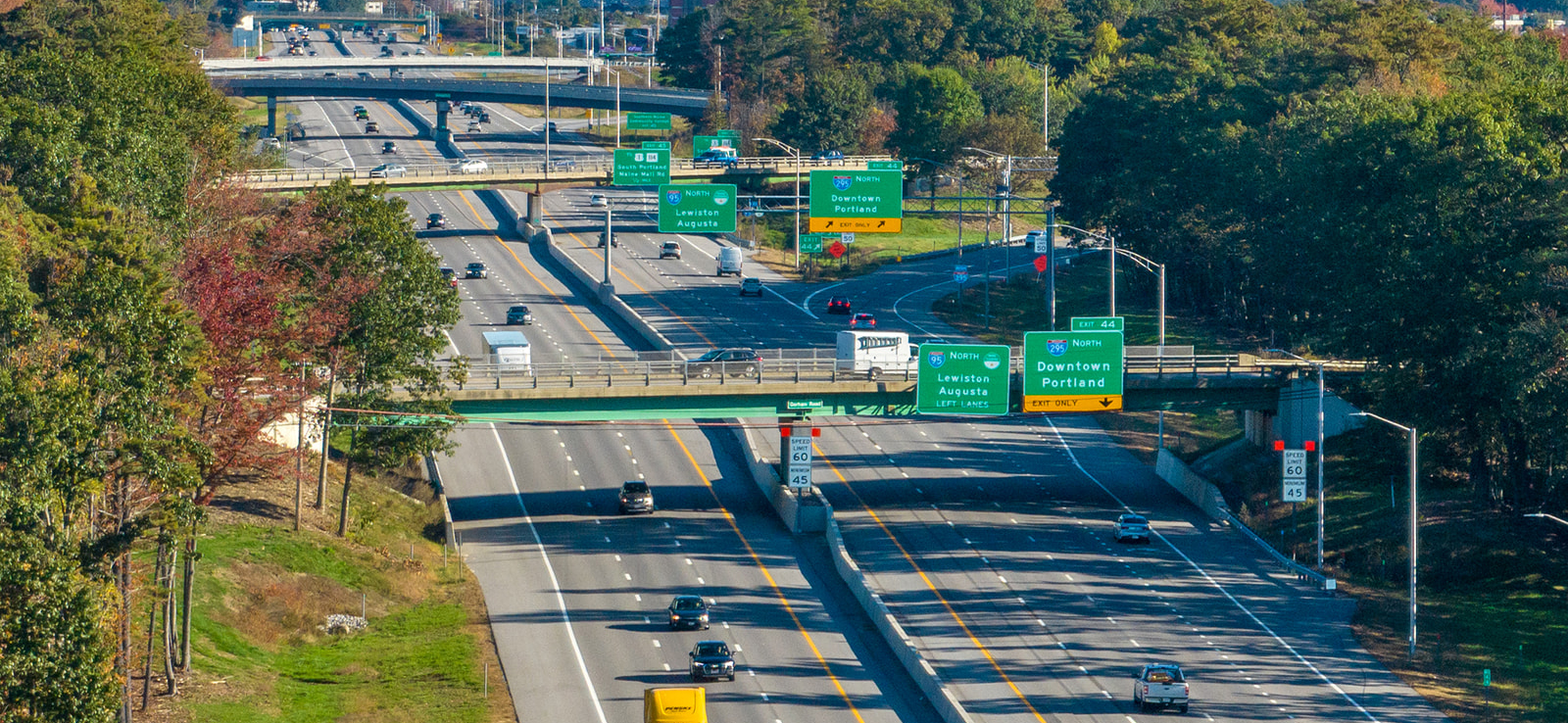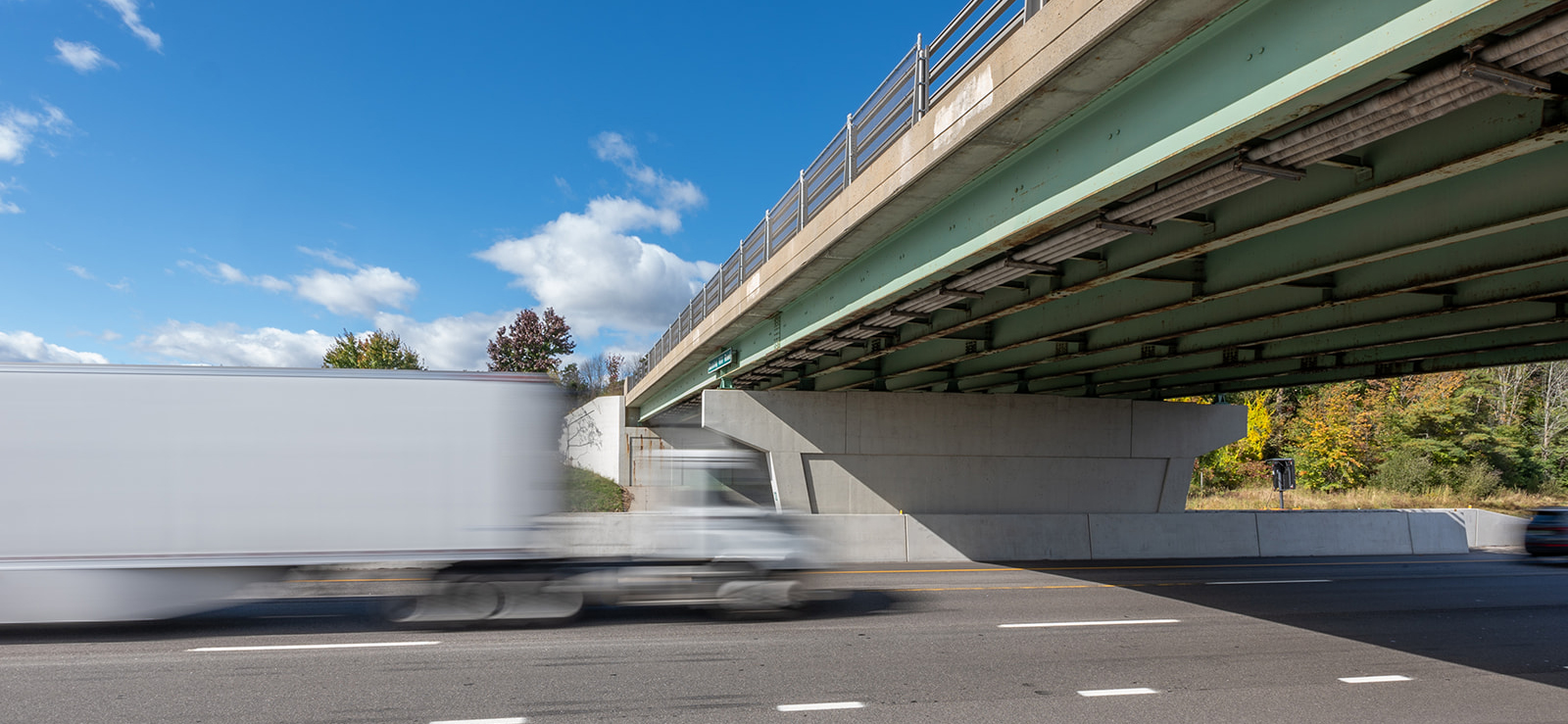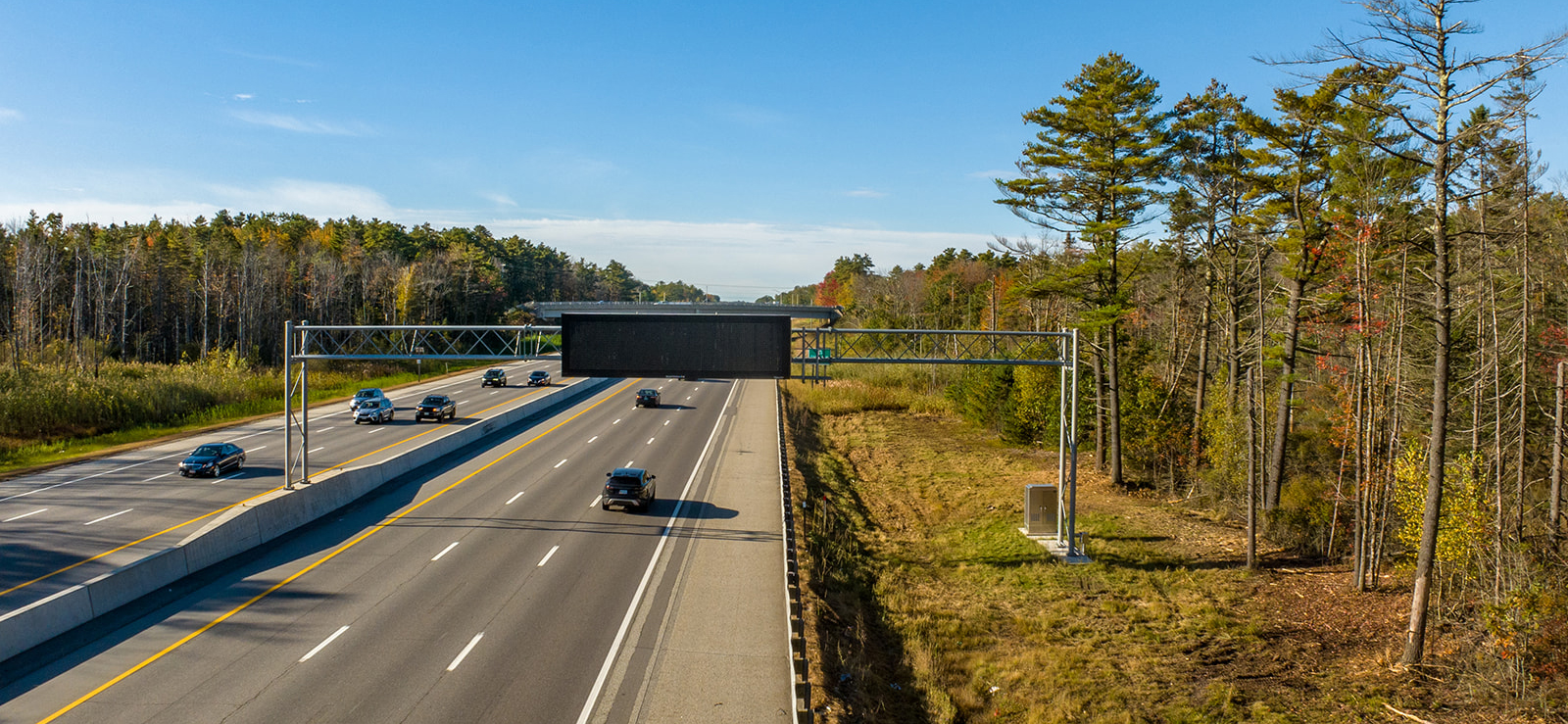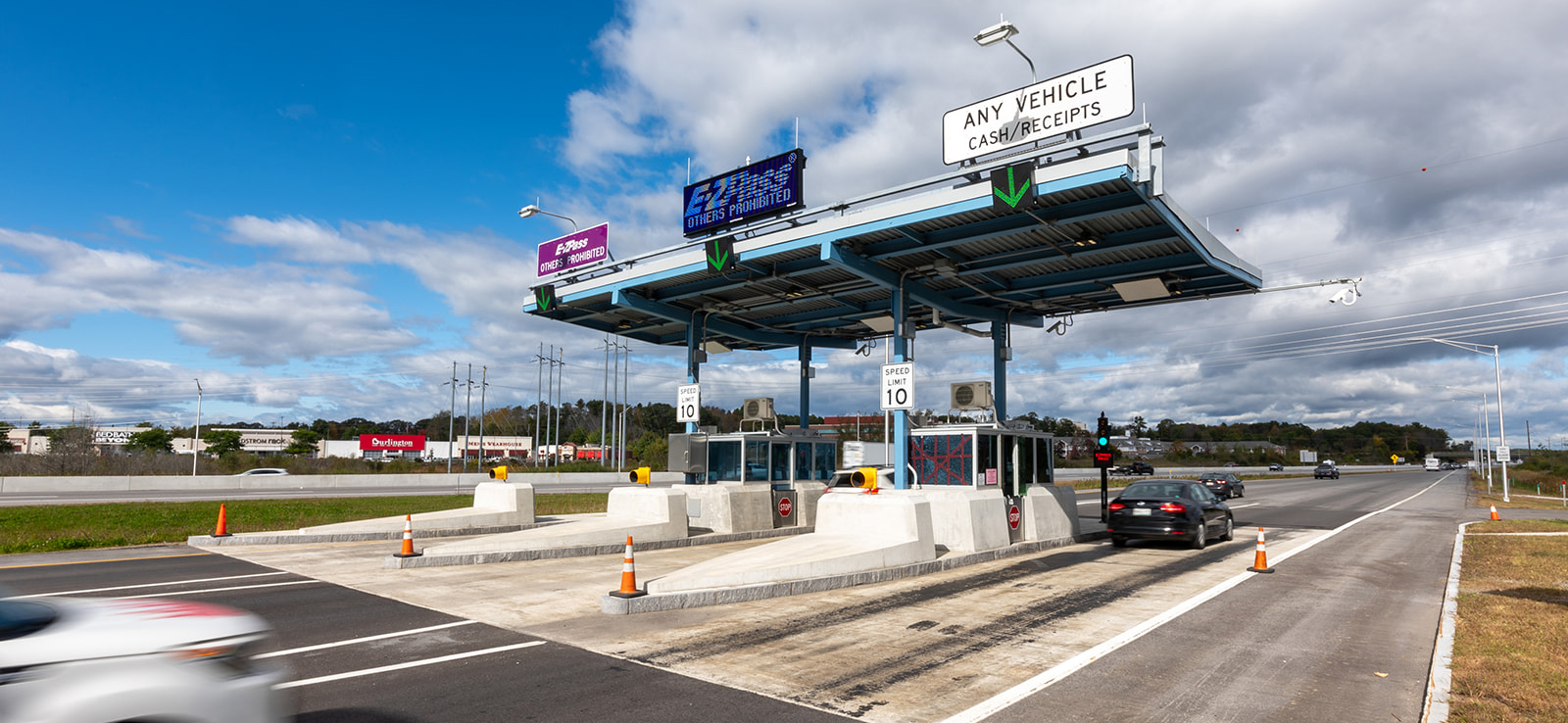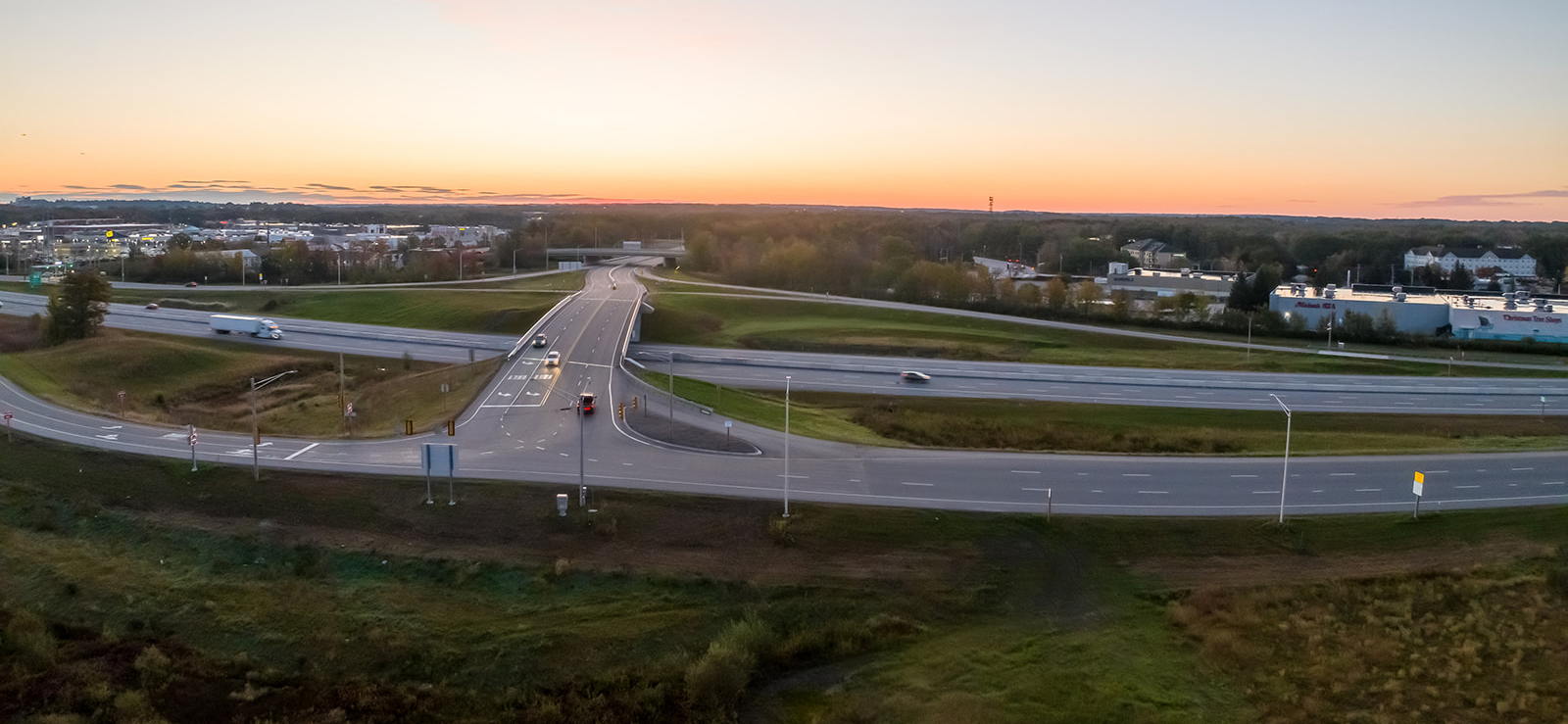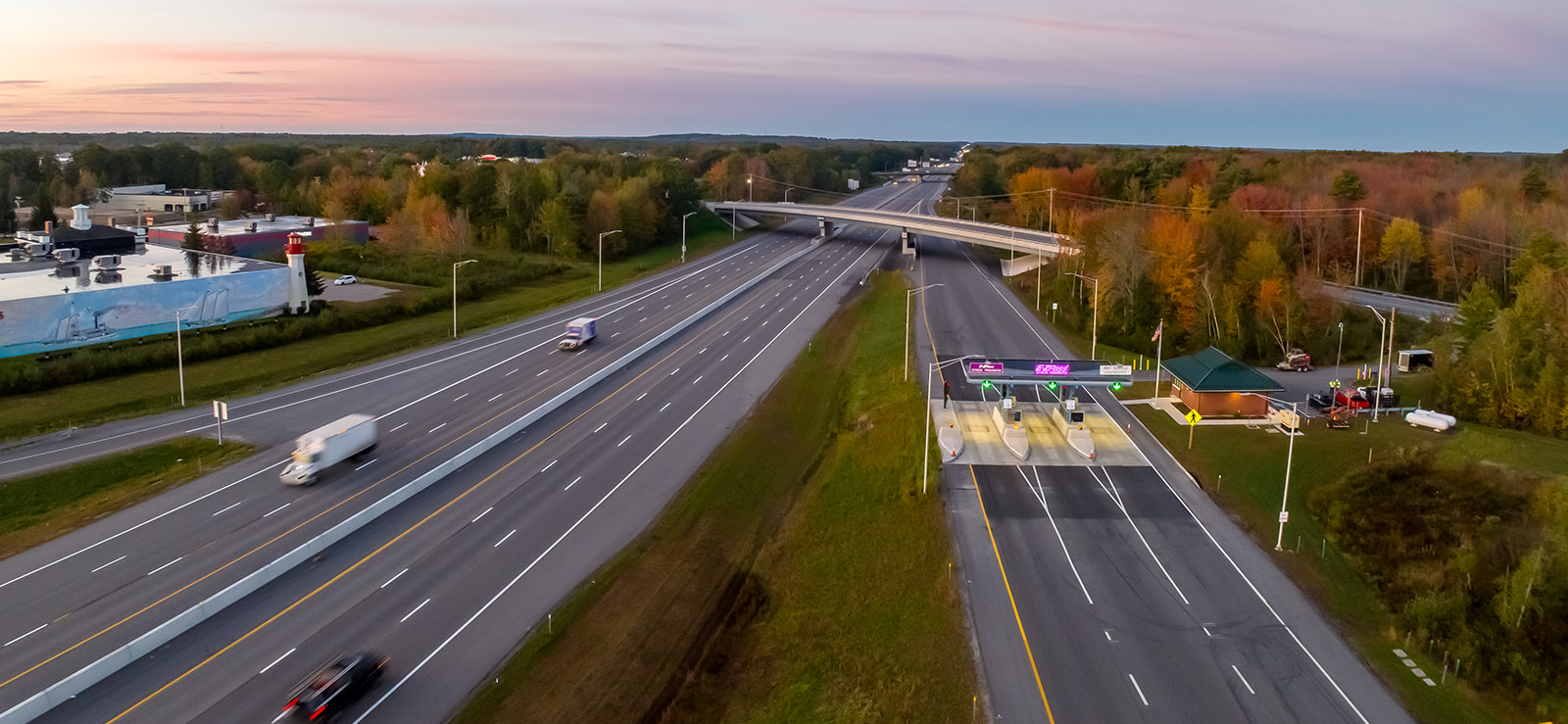The Maine Turnpike Authority’s historic widening program increases safety, mobility and the opportunity for continued economic development in greater Portland and throughout Maine
DESIGNER
2024
For decades, Portland area motorists have relied on the Maine Turnpike as a safe, reliable shortcut around downtown. More than six decades after its opening in 1955, traffic volumes within the greater Portland area have increased 25-fold leading to increased congestion and crash rates. Carrying over 60,000 vehicles per day, the 6-mile section of the Maine Turnpike through Portland needed improvement to ensure travelers received the safe, reliable travel experience and to accommodate projected growth.
In 2018, recognizing the need to address growing congestion, the Maine Turnpike Authority approved the most extensive capital program in its history: the $204 million Portland Area Widening (PAW) and Safety Improvement Program. Paid entirely by tolls, the program expanded the turnpike to six lanes from south of Exit 44 to Mile 49, rebuilt multiple bridges and widened four overpasses to accommodate the added roadway width, and reconstructed the Exit 45 interchange. The Turnpike Authority also invested heavily in safety features, including 12-foot-wide outside shoulders, a 26-foot-wide paved median featuring a 36-inch concrete barrier and enhanced signage.
Five years later, commuters, streams of freight customers and a surging number of Maine tourists enjoy safer, smoother, more reliable trips thanks to the five miles of newly widened roadway.
Identifying what’s important
To help plan, design and deliver the program, the Turnpike Authority turned to its long-time general engineering consultant, HNTB.
“We asked the Turnpike Authority what was important to them. Overwhelmingly we heard a desire for increased safety and mobility to support the Turnpike’s core goals of providing a safe, efficient and reliable roadway. Moreover, they wanted a cost-effective program constructed in a manner that minimized congestion for the Turnpike’s patrons.” said Tim Cote, HNTB program manager.
Over nine years, the project team provided a comprehensive range of services to meet the Authority’s goals. HNTB tapped multiple in-house disciplines for their expertise beginning with planning, public outreach and environmental services. Throughout design the diverse multidisciplined team combined highway, bridge, traffic, drainage, geotechnical, tolling and intelligent transportation systems design services to compile a comprehensive set of contract documents. As the project moved into construction, inspection and oversight services were provided.
Achieving stakeholder consensus
The Northeast doesn’t see many highway expansion projects these days. For one, few urban corridors have the additional right-of-way, and two, when the right-of-way does exist, expansions are often met with strong opposition. But not this one.
“The environmental permitting process was seamless with no controversy, which I think is pretty amazing,” said Peter Merfeld, Turnpike Authority chief operating officer.
The Turnpike Authority owned the right-of-way for the new lanes and took measures to minimize opposition by evaluating 19 alternatives, 10 of which the Turnpike Authority added based on input from multiple advocacy and environmental groups, collectively known as the Public Advisory Council (PAC).
HNTB organized the PAC and conducted meetings between the group and the Turnpike Authority.
“HNTB was stellar at explaining the necessity of the project,” said Peter Mills, Turnpike Authority executive director.
“We shared the challenges and asked for the PAC’s help to solve the problem,” said HNTB’s Paul Godfrey, public process lead. “They saw the viable options and understood that adding capacity wasn’t the only solution but an appropriate and prudent path forward.”
Because the Turnpike Authority involved the PAC in the discovery and decision-making process, none of the groups opposed the final recommendation to widen the roadway.
“Presented with all the facts and alternatives, the PAC reached a consensus on their own,” said Turnpike Authority Public Outreach Manager Erin Courtney.
The Portland Area Widening & Safety Improvement Program
11 construction contracts
5 years of construction
16 bridges modified
4 interchange modifications
1 interchange reconstruction
1 toll plaza replacement
4 large culvert extensions
2 new emergency vehicle ramps
5 centerline miles of widening, drainage, median barrier and safety improvements
Promoting a competitive bidding environment
To avoid the risk of the historic program becoming too large for local contractors, the work was separated into 11 construction contracts, ultimately generating at least two bids per package and a program total of 33 construction bids. The strategy set the tone for the cost-effective program the Turnpike Authority was after. Construction commenced just before the COVID-19 pandemic struck in March 2020.
“Contractors were concerned new health and safety restrictions would prohibit them from meeting scheduled milestones,” said Dale Mitchell, HNTB highway widening project manager. “Having a contractor walk away from a contract was not a workable solution for anyone.”
After listening to contractors, the Turnpike Authority added one year to the construction timeline, alleviating concerns. Additionally, COVID-related changes in travel patterns allowed the Turnpike Authority to relax work restrictions and reduce the need for nighttime construction, regaining any momentum the program had lost.
“The widening kept the southern Maine economy alive that summer,” Mills said.
Maintaining a premium roadway
At the height of the program, there were three to six active construction projects happening concurrently, all with interdependent work scopes and outcomes. However, the interrelationship of these contracts meant that, if one fell behind, the entire program would be impacted.
Recognizing this, and in response to the Turnpike Authority’s desire to minimize construction impacts on traffic operations, the team spent considerable time analyzing options for sequencing and phasing the work with the goal of maximizing efficiency and safety also while minimizing risk. The result was a detailed and time-bound contracting and sequencing plan for the program outlining the limits and scope of construction for nearly a dozen separate contracts. The plan provided a clear understanding of the relationship between each contract's respective schedule, work zone, traffic control signage and construction access. The team also identified critical milestones and limitations of operations to ensure that impacts did not unacceptably affect adjacent construction projects, while maintaining safe work zones for workers and the traveling public. Numerous temporary traffic control layouts were required. In some cases, night and weekend interchange closures were permitted to expedite construction and further enhance safety for motorists and workers alike.
“Rapidly changing travel patterns during the pandemic presented both a challenge and an opportunity. While reductions in traffic volumes translated into greater contractor flexibility, understanding the changes required ongoing data collection and assessments,” said Ariel Greenlaw, HNTB lead traffic engineer.
The team’s approach resulted in a comprehensive and well-reasoned approach to construction sequencing and traffic management that thoughtfully balanced contractor needs, safety and mobility. Because free flow conditions were maintained at almost all times during construction, the delay experienced by motorists was minor.
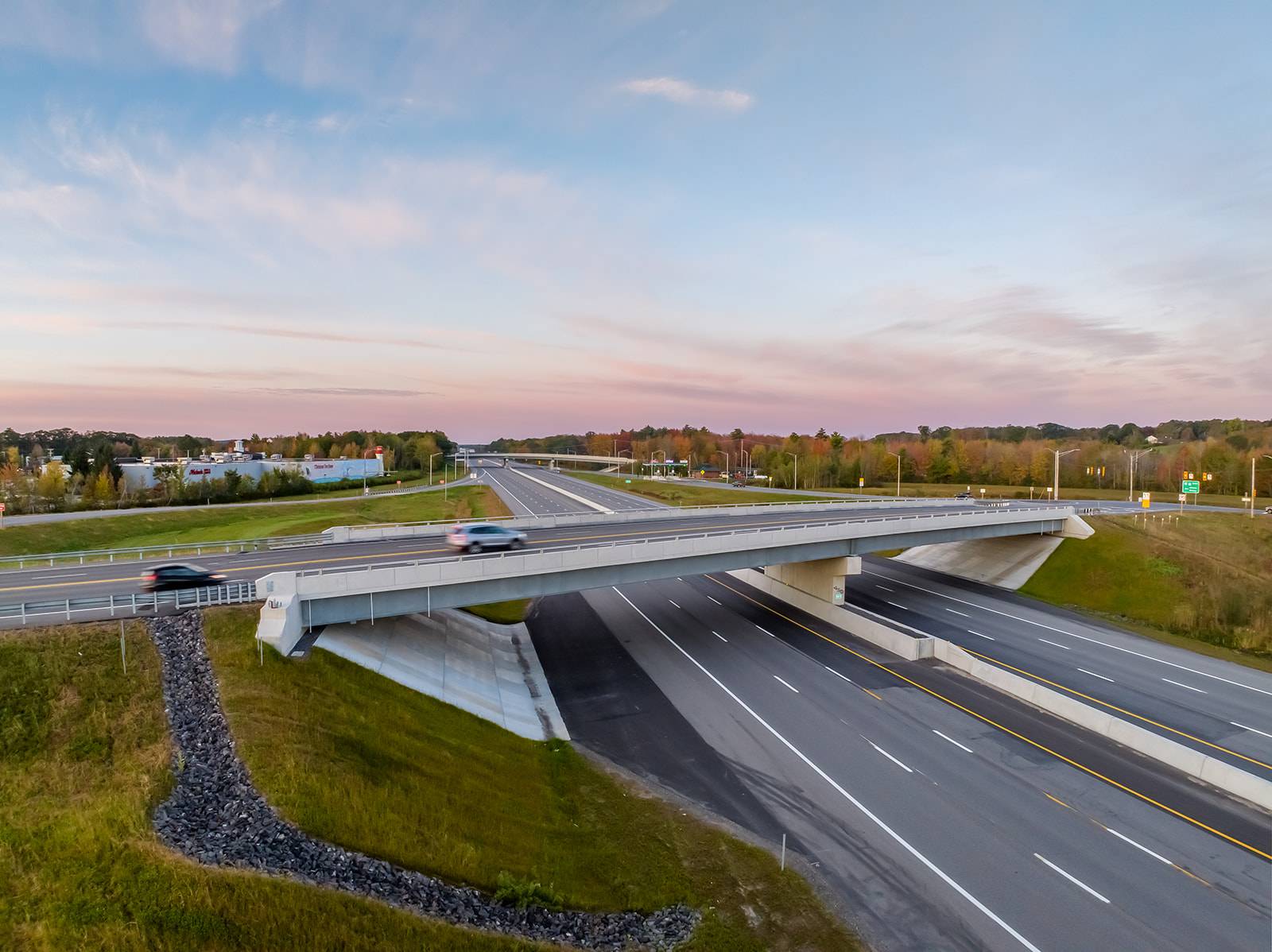
“The widened facility provides a safer, smoother highway, reduced congestion, greater trip reliability and prepares the growing Portland area for continued economic growth.”
Delivering an interchange for today and tomorrow
Under the PAW program, the Turnpike Authority improved five interchanges, including transforming the Exit 45 interchange. The interchange, dating back to the 1950’s, is situated on some of the worst clay soils in the northeast, and experiences a high number of crashes, has a functionally obsolete bridge with substandard underclearance over the Turnpike mainline, has outdated tolling infrastructure and was colocated with significant utilities. Moreover, the interchange is the optimal connection point for a new future roadway to the west. This required developing a design that satisfied current operational needs while readily accommodating future expansion. The Turnpike Authority and HNTB addressed these multifaceted conditions and delivered the transformed interchange in the following three construction contracts:
- Preloading
To overcome the challenging subsurface soil conditions, a composite geotechnical solution was developed including embankment preload coupled with zones of lightweight fill. The initial preload contract increased the shear strength of the area’s soft soils and reduced post-construction settlement.
“As the preload contract neared completion, it was rewarding to see that the 7 feet of settlement predicted by HNTB was remarkably accurate,” said Ray Hanf, HNTB Exit 45 interchange project manager.
- Utility relocation
Under the utility relocation contract, HNTB orchestrated moving three high-voltage transmission lines, two 34,000-volt lines and an 115,000-volt line.
- Interchange, bridge and toll plaza construction
The HNTB designed interchange converted the existing trumpet interchange into a diamond configuration. In anticipation of a future connector road from the west, the interchange design accommodates further expansion into a diverging diamond recognizing the area will serve as a significant mixing point for traffic.
Answering RFIs in 7 days
HNTB’s construction support efforts included a commitment to respond to contractors’ requests for information in 10 days or fewer, including weekends, to support the timely completion of the project. The firm averaged just seven days over the five-year construction schedule.
In addition, the redesigned interchange features longer north and southbound entering and exiting ramps for safer merging and deceleration respectively and replaced the obsolete toll plaza with a modern facility with upgraded toll technology.
A new interchange bridge was also designed, replacing the substandard 1950s structure – making a substantial safety gain in itself as the old low-clearance structure had suffered repeated impacts from over-height vehicles.
Recognizing that closing the interchange to traffic during construction was not feasible, HNTB worked with the Maine Turnpike to develop a six-phase approach to construction and traffic management.
Through these discussions, the team decided to allow for three weekend interchange closures to facilitate critical work activities. The weekend closures were critical to completing the work safely and efficiently.
When construction began, the HNTB team shifted to inspection, reviewing everything from the roadway to the bridge to the toll plazas and equipment.
Improved mobility
Opening the Exit 45 interchange in October 2022 marked a significant project milestone and the culmination of a separate significant Turnpike effort — their decade-long transition to a new and enhanced tolling system. One year later, in October 2023, the program achieved substantial completion with the construction completed on time and under budget. Despite record-setting traffic volumes, mobility through the corridor has increased, crashes are down and customers now enjoy a safer and more modern roadway.
“In an area with alternative routes, our turnpike is by far the most attractive. The widening program is a great example of what makes our road so attractive” said Greg Stone, Turnpike Authority director of public safety.
The widened stretch of turnpike is expected to serve the growing Portland area well into the future.
“This is an exciting day in the evolution of transportation in Maine,” said Mills. “We are always responding to capacity challenges as we manage the greatest flow of vehicular traffic that exists in the state of Maine. This project will have a dramatic impact on reducing congestion through this busy corridor."
SEE MORE ARTICLES
MORE DESIGNER STORIES
FISH PASSAGE PROGRAM
RUNWAY 13L-31R
KC LEVEES PROGRAM
DENVER INTERNATIONAL AIRPORT
CENTRAL INDUSTRIAL DISTRICT (CID)

